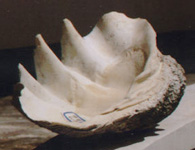Giant Clam is a member of the Tridacnidae family of Eulamellibranchia order in Lamellibranchia class. Because the groove in its costal region is very deep, which looks like the wheel-track ground out by wheels, it is also reputed as "carriage ditch" in ancient times. It is mainly distributed inHainan Province and sea areas of South China Sea islands.
 |
|
It has two massive shells slightly similar to triangle, which are equal in size but asymmetric. The forepart of shell is relatively short and there is a byssus aperture in the front of umbo. The larvahas a strong protruded byssus in the concave part of the front of umbo, but when grown up, the byssal aperture is closed. Its external ligament is narrow and long -- almost as long as the rear end of shell, and in the color of chocolate brown. Its dorsal edge is flat and ventral edge has corrugation. The two shells cannot be closed utterly. The surface of shell is white, with 5 strips of powerful imbricate tierceron ribs. Its growth ring is obvious, forming overlapped curving goffers on the shell surface. The inside shell is white and lustrous. There is a inter-rib groove in the opposite position of tierceron. The two shells, respectively with a main tooth and a posterior lateral tooth, have a narrow and long junction. The front closing muscle has vanished while the rear closing muscle is developed.
As a stenohaline shellfish with high salinity, Giant Clam dwells in the neritic region of the tropical zone, fond of resting among coral reefs near the lower tidal lines. The larva's umbo protrudes strong byssus, with which it attaches its body to coral reefs or sandy seabed. Although the adult is no longer fixed, the shell opening is still upward. It has a developed mantle with a sort of special construction that can polymerize sunshine, which enables symbiotic zooxanthellae to reproduce in large quantities. On the other hand, carbohydrate produced by zooxanthellae can be absorbed by Giant Clam as its primary nourishment. In this way, a kind of reciprocal symbiosis relation is established between the two species of creatures.
